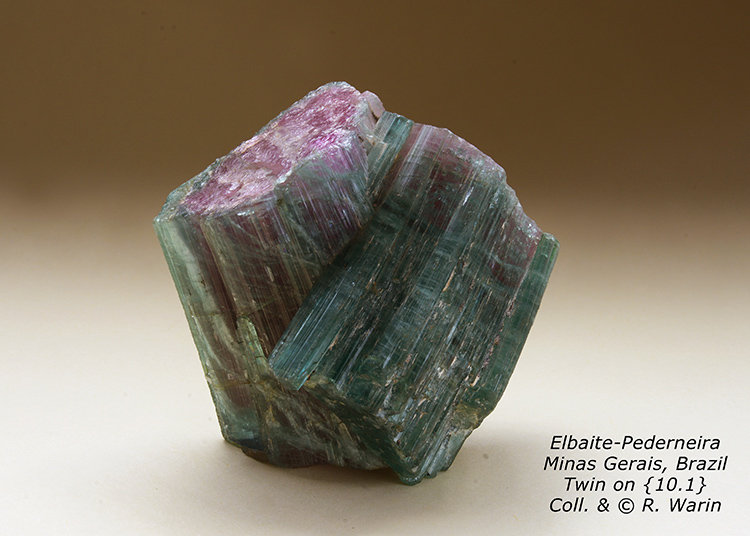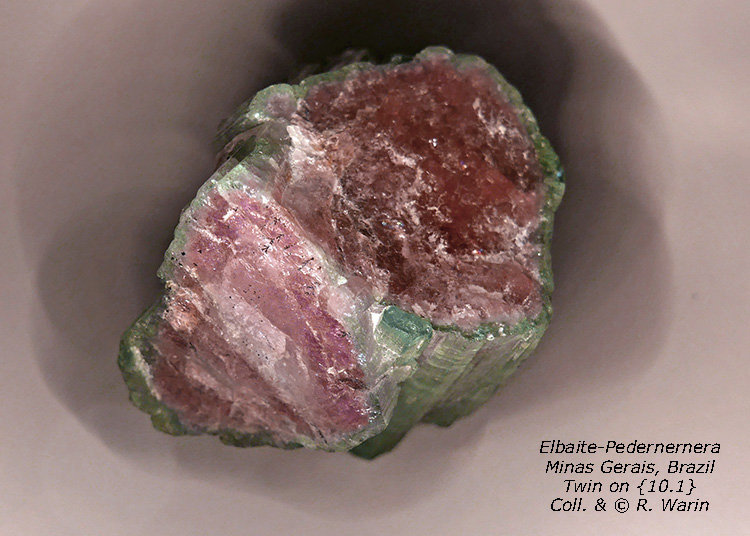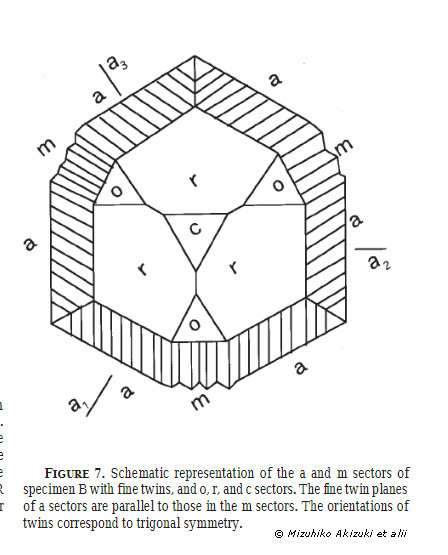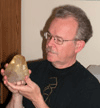| View previous topic :: View next topic |
| Author |
Message |
Roger Warin

Joined: 23 Jan 2013
Posts: 1243



|
 Posted: Jan 02, 2023 14:30 Post subject: About the tourmaline twin Posted: Jan 02, 2023 14:30 Post subject: About the tourmaline twin |
|
|
Hello,
Happy new year 2023.
I recently had the opportunity to acquire this fine specimen of elbaite from Pederneira. It was purchased from Idar-Oberstein in the 1960s.
This is the twin {10.1} reputed to be very rare and poorly documented in tourmaline.
However, it could appear more often as a twin at the end of growth, highlighted in particular by optical observations of thin sections of tourmaline such as liddicoatite from Madagascar (polysynthetic twins).
I had seen several years ago in a museum in Idar, an oval section perpendicular to the c axis (without comment) which I attributed to this twin.
The angle between the two axes c seems close to 40°.
Thank you for helping me.
Crystal height ≈ 5.5 cm.
MIZUHIKO AKIZUKI et alii.
American Mineralogist, Volume 86, pages 364–369, 2001
| Mineral: | Elbaite |
| Locality: | | Pederneira claim, São José da Safira, Governador Valadares, Vale do Rio Doce, Minas Gerais, Brazil |  |
|
| Dimensions: | crystal width = 5.5 cm |
| Description: |
|
| Viewed: |
11603 Time(s) |

|
| Mineral: | Elbaite |
| Locality: | | Pederneira claim, São José da Safira, Governador Valadares, Vale do Rio Doce, Minas Gerais, Brazil |  |
|
| Description: |
|
| Viewed: |
11598 Time(s) |

|
| Mineral: | Liddicoatite |
| Description: |
|
| Viewed: |
11595 Time(s) |

|
|
|
| Back to top |
|
 |
James Catmur
Site Admin

Joined: 14 Sep 2006
Posts: 1479
Location: Cambridge



|
 Posted: Jan 06, 2023 11:35 Post subject: Re: About the tourmaline twin Posted: Jan 06, 2023 11:35 Post subject: Re: About the tourmaline twin |
|
|
| I have to admit that I am trying to get my head around this. Do you have more examples?
|
|
| Back to top |
|
 |
Bob Morgan
Joined: 18 Jan 2018
Posts: 251
Location: Savannah, Georgia



|
 Posted: Jan 06, 2023 12:59 Post subject: Re: About the tourmaline twin Posted: Jan 06, 2023 12:59 Post subject: Re: About the tourmaline twin |
|
|
I question whether this is twinning or parallel growth across what would be 'm' faces in the drawing. Nearly every tourmaline has striated prism faces, which doesn't require twinning. Since tourmaline is polar, the terminations of each twin would be different from those next to it. I have yet to see that on any tourmaline. Since your specimen lacks terminations, it's impossible to confirm twinning.
When it comes to a nonparallel c-axis twin where the two crystals cross each other, more examples are needed to confirm such a twin law.
It's lovely but probably not a twin.
|
|
| Back to top |
|
 |
Bob Morgan
Joined: 18 Jan 2018
Posts: 251
Location: Savannah, Georgia



|
 Posted: Jan 06, 2023 13:03 Post subject: Re: About the tourmaline twin Posted: Jan 06, 2023 13:03 Post subject: Re: About the tourmaline twin |
|
|
| Also, the two crystals appear to have separate origins, and have simply crossed each other without a twin start.
|
|
| Back to top |
|
 |
John S. White
Site Admin

Joined: 04 Sep 2006
Posts: 1298
Location: Stewartstown, Pennsylvania, USA



|
 Posted: Jan 07, 2023 07:18 Post subject: Re: About the tourmaline twin Posted: Jan 07, 2023 07:18 Post subject: Re: About the tourmaline twin |
|
|
I see no reason to suggest that the pair of crystals in the photo are twinned. In fact I do not believe that tourmaline is known to twin.
_________________
John S. White
aka Rondinaire |
|
| Back to top |
|
 |
lluis
Joined: 17 Nov 2006
Posts: 719


|
 Posted: Jan 07, 2023 08:56 Post subject: Re: About the tourmaline twin Posted: Jan 07, 2023 08:56 Post subject: Re: About the tourmaline twin |
|
|
Well, I am too bad to see the twinning, but searching for twinning in tourmaline, I found this article that says that are rare, but do EXIST
https://www.ehu.eus/mineralogiaoptica/turmalina.html
(link normalized by FMF)
With best wishes
Lluís
|
|
| Back to top |
|
 |
Pete Richards
Site Admin

Joined: 29 Dec 2008
Posts: 846
Location: Northeast Ohio



|
 Posted: Jan 07, 2023 10:50 Post subject: Re: About the tourmaline twin Posted: Jan 07, 2023 10:50 Post subject: Re: About the tourmaline twin |
|
|
Some comments about the tourmaline twin:
1. Twinning in tourmaline is mentioned by some authors, always as uncertain or rare. To those already mentioned can be added R.V. Dietrich's (1985) monograph The Tourmaline Group. He summarizes his discussion by saying "Among hundreds of specimens examined by the writer, only a few possibly twinned crystals were seen. In any case, tourmaline crystals ... commonly occur as intergrowths that can simulate twins whenever the angular relations are nearly (or exactly) rational. Consequently, statistics may be needed to establish twinning in tourmaline." Statistics require a large number of observations. A large number of observations of something rare is almost impossible to accumulate, so twinning in tourmaline is unlikely to be established by a statistical approach.
2. The interesting diagram of Akizuki et al shows a very special case of twinning, on the rim only, of a mixed liddicoatite-elbaite crystal from Madagascar. In the paper cited, the authors show that this outer rim consists of liddicoatite with reduced (triclinic) symmetry, and it is polysynthetically twinned. The authors do not give a twin relationship, but from the diagram it is reflection on (11-20) of the main crystal. (11-20) cannot be a twin plane for normal trigonal tourmaline because it is already present as a mirror plane in the untwinned crystal structure. It becomes a candidate for a twin plane in this case because of the reduced symmetry of the rim tourmaline.
3. The elbaite crystal shown here has no obvious relationship to the diagram of Akizuki, and I am not sure what is intended by including the diagram. As others have commented, the elbaite appears to me to be two crystals associated by accident of growth, which must have started growth at two different points on the matrix, and therefore cannot be considered a growth twin. The lack of terminations makes establishing a special orientation, as would be required for twinning, nearly impossible. The twin law is stated as (10.1) and the angle between the two crystals as about 40°. However, a twin on (10.1) would have an angle between the two individuals of 55° to the nearest degree.
I reluctantly conclude that this is not a twin.
_________________
Collecting and studying crystals with interesting habits, twinning, and epitaxy |
|
| Back to top |
|
 |
|





